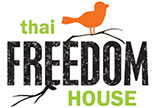How did we come to be?
Our founder, Lisa Nesser, came to Thailand in 2004 to work with refugees from Burma after having worked for several years in Southern India with refugees from Tibet and previously with refugees from Bosnia in her hometown in Saint Louis, MO, USA. She served as a volunteer along the Burma border in an orphanage for about 9 months before coming to the ancient and at the same time, very modern city of Chiang Mai to lead trainings on Democracy, Environmental Protection awareness and more for adult refugees living here. Shortly after arriving in Chiang Mai it became clear to her that there was a large portion of the city’s population who had little to no access to formal or informal education. The few small drop in centers and safe houses could not serve the large population of displaced peoples from Burma and the mountains of Northern Thailand.
In October 2005, Thai Freedom House was born in Lisa’s home in the NE pocket of the old walled city. It was surrounded by construction sites where workers undertook the most dangerous jobs with the least legal protection, children who were forced to support their families by working in bars at night selling flowers until 3am, and young adults who were completely illiterate and therefore vulnerable to the worst of SE Asia’s problems—including human trafficking and exploitation.
Lisa did a lot of outreach in the 5 months before formally starting the learning center. Getting to know the ethnic minority people of the area, she taught impromptu classes in front of the bars where children worked alongside their mothers selling handicrafts and strands of jasmine. She visited homes in the slums that were built above drainage ditches because it was the space no one owned—they were literally living in the air on planks over the most vile, stagnant water you can imagine. Gaining the trust of the people she wished to serve, she learned more about their challenges and became the liaison between existing organizations, government representatives, school headmasters, ethnic families and construction site workers whose children also had no access to education and largely came from ethnic minority groups in Burma. She was working alone, without an organization and learning how to navigate the various systems at play in Thailand. This groundwork would prove essential later on as the organization grew.
Lisa couldn’t find an organization that was serving the varied and numerous needs of the people she was encountering and developing relationships with. It was impossible to register the students in Thai schools at the time because they lacked the required documentation and there were no classes for them that were flexible enough for their living situations. She decided to open her own center, in her own home, to address the most prevalent needs that she saw. By providing a healthy, fulfilling daily meal, a safe house where students and their family members could gather and use as a community space, they could share their challenges and receive the much desired education that they sought. The first location was in her little house which she painted the brightest colors possible, put some floor mats down and strung white boards in front of the windows. Daily classes in Thai and English language and the arts were offered along with a family style dinner every evening. From the beginning, it was clear that this was going to be an organically grown community that was to serve as an extended family to the displaced people that gathered there. The property had a huge garden with a mango tree that often provided the daily snack, fresh medicinal herbs for tossing in curries, ferns and flowers to place in pots inside the classrooms and a plot next door where Lisa built a teepee and a fire pit to make additional outdoor class space. Physically, the center is in a ‘house’, but it has taken the identity of a ‘home’ for those that pass through it’s doors.
What’s in a name?
We are often asked why we chose to name our learning center Thai Freedom House. Since the majority of our students are from the Tai (close in spelling and pronunciation to Thai) ethnic minority group in Burma, our name can cause some confusion.
The obvious meaning is that, through education, we give people a sense of freedom by showing them that their minds cannot be caged in, that they are free in their thoughts and aspirations and no one can take this freedom away from them.
We serve people who have little to no access to formal education and even less access to other basic human rights. Many face prejudice from their host country and fear of their homeland and the conditions there. By providing them with education we give them a kind of freedom in their mind that they cannot attain any other way.
There is another, deeper, less obvious meaning to the name and it is very personal. Our founder Lisa Nesser is from Saint Louis, Missouri in the USA, and when she was in high school she had heard about an historic school in Saint Louis started by a Pastor Meachum: Freedom School. She always found the story fascinating and inspirational. This influenced her decision to name the school Thai Freedom House as she recognised the similarities between the struggles experienced by the African American people of Saint Louis at that time and the marginalised refugees in Thailand today.
Explore St Louis details the work of Pastor Meachum in the following excerpt:
In 1818, the First African Baptist Church became the first black church in St. Louis. The church was run by Pastor John Berry Meachum, an architect of the St. Louis Underground Railroad. A slave himself, Meachum was able to buy his freedom and subsequently the freedom of his family, but he didn’t stop there. As a savvy businessman, he accumulated wealth and purchased slaves, then taught them a trade and freed them. Later in his career, he opened a clandestine school in the basement of his church to teach blacks to read and write. In 1847, a more strict law was passed which prohibited the teaching of blacks, so Meachum’s solution to build a steamboat and anchor it in the middle of the Mississippi River. Called the Freedom School, his school was allowed to remain because the river was under Federal jurisdiction rather than state. Many black students were educated here during the 1840s and 1850s. Drive down Leonor K. Sullivan Blvd., St. Louis’ old Wharf Street, to see the majestic river where Meachum’s school was anchored.
(http://www.explorestlouis.com/itineraries/blackHistory.asp)
Here is what our founder, Lisa has to say about the name:
What we are doing here in Thailand: educating refugees and minority group members that are denied access to basic education and human rights elsewhere, follows in the same vein as Freedom School in Saint Louis, MO, USA as Thai Freedom House is a way to get around those limitations while still getting done what needs doing by providing education and vocational trainings to the most vulnerable members of our community. I chose to call us a ‘house’ rather than a ‘school’ because we are a family and I want to encourage the feeling of unconditional love and support, togetherness, interdependence and trust that you should have with your family. Many of our students have left their extended families behind to journey to a new land and don’t have the traditional support systems that the rest of us enjoy. Thai Freedom House is a place for them to feel at home.

